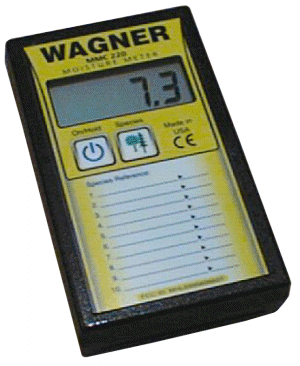|
|
|
| Description The model MMC220 is one of the more popular Wagner meters. It is a pin-less design and will measure moisture (EMC) in the 5% to 30% range in material 0.75 to 1.5 inches thick. A protective case is also included. The MMC220 uses electromagnetic radio waves (EMF) to measure moisture. To obtain a reading the EMF flow through the material is measured. This effectively is a measurement of the board's density and (within the same species) the denser a board, the more moisture it contains. Different species of wood have varying levels of (static) density (called specific gravity) so there is an adjustment factor to take this into account as well. Several species are listed in the manual but custom settings can also be applied for those not listed. The advantage of using EMF is that it creates a three dimensional field of measurement as opposed to just at the wood surface where the pins contact the wood. |
 |
| Why use a moisture meter? If you are using properly
dried wood, you don't need to. The problem is, how do you know that the wood IS properly
dried? Wood with too high or too low of a moisture content will change shape and can cause
problems such as warping, checking, opened joints, and sticking or ill fitting doors and
drawers. In the worst cases it can even cause joint failure. It is standard good practice to let wood for a project acclimate in the shop before it is used. Instead of relying upon faith, a moisture meter such as this gives a direct reading to let the craftsman know what the moisture level really is and if the material is ready to be worked. It is widely accepted that wood used for indoor projects should be somewhere within the 7% to 10% range (Wagner says 6 to 8 percent). However, in areas with higher or lower average relative humidities, the range may extend a percentage or two one one side or the other of this range. Basically, the ideal moisture content is determined by your particular environment. |
|
| In Use The MMC220 is super simple to use, so simple it's actually hard to come up with anything to write about. About the only caveat there is in using the meter is to make sure you have the specie setting correct. Otherwise the value may be off a little. Since the MMC220 is only rated to measure material 0.75 inches thin, if thinner stock is measured it could be backed up by similar material to achieve the minimum thickness. In practice though, I've not noted any real difference in the thinner wood I've measured. When measuring rough sawn lumber, the reading will be a little less than that same material after planing. Wagner recommends adding 1 to 2 percent to these readings. A typical moisture meter such as this is designed to read solid lumber but man-made materails can also be read although a correction factor will need to be appiled (due to the glue used in these materials). Another beauty of a pin-less meter is that one can read the EMC of existing projects in the home for a comparison without any damage (such as pin holes) to the surface. This can lead to some interesting data. The MMC220 has a press / hold feature that can be used when the meter cannot be viewed on the stock. It also has extended range for exotic species and an auto-off feature which saves the battery In addition to moisture meters, Wagner also makes a Calibration Verification Block so the meter can be checked against a standard. |
| Summary The Wagner MMC220 moisture meter is easy to use and has been proven accurate in my limited methods of checking this. A moisture meter is a pretty valuable shop tool because it keeps the craftsman from using material before it is ready thus paying for itself by saving both time and money in the long run. I especially appreciate the pin-less design and would not recommend any other type for furniture building. If you are serious about your woodworking reputation then a moisture meter is almost a requirement. If you are in the building trades installing floors and whatnot, it would be truly unwise to operate without one. |
In the interest of full disclosure Wagner provided this product to facilitate this review.
|